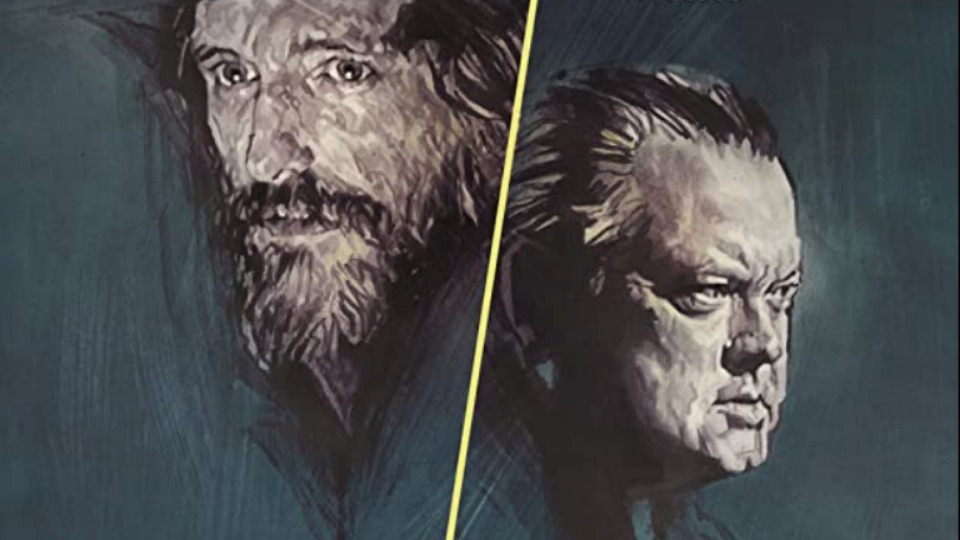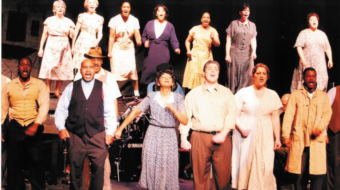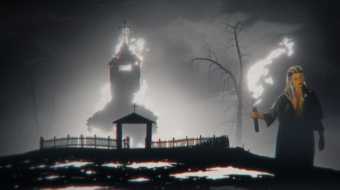
The documentary Hopper/Welles, which screened at the 34th annual AFI Fest, is to film history what 1989’s When Harry Met Sally is to romcoms. It consists of a conversation/interview between two renegade actor/directors who made touchstone movies but were nevertheless Hollywood outcasts. Following a stunning career as a radio and Broadway Wunderkind, Orson Welles starred in, co-wrote and directed his first Hollywood feature when he was only 25. That 1941 masterpiece Citizen Kane scored the Best Writing, Original Screenplay Oscar for Welles and Herman Mankiewicz and received eight more nominations, including in the Best Picture, Best Director and Best Actor Academy Award categories. But as far as the Tinseltown studio system went, it was all downhill from there in terms of directing for RKO, et al, for poor Orson.
As another enfant terrible, Dennis Hopper’s movie career followed a similar tragic trajectory. He acted in numerous TV and film productions, notably with his idol James Dean in the 1950s movies Rebel Without a Cause and Giant. Hopper’s immensely profitable directorial debut was the 1969 counterculture classic Easy Rider, which Hopper also co-starred in and co-wrote, receiving an Oscar nom for doing so. Riding high on his youth culture hit, the New Hollywood golden boy could write his own ticket but, like Welles, Hopper went on to have a turbulent, troubled career.
Welles encountered Hopper when Dennis was in the process of making the first feature he directed after Easy Rider, the 1971 avant-garde film The Last Movie, shot on location in Peru. Portraying (more or less) himself, Hopper was part of the star-studded cast of Welles’s The Other Side of the Wind, one of the many ill-fated, self-financed motion picture projects Welles started shooting in the early 1970s, although a version of it wasn’t released posthumously until 2018.
Hopper/Welles came about as a filmed interview by an offscreen Welles with Hopper, which the former intended to enfold inside Wind. According to AFI Fest’s notes, this extended tête-à-tête was “Found in 2017 amid 1,083 reels of production footage” when producer Filip Jan Rymsza and editor Bob Murawski were going through Welles’s voluminous materials for Wind and piecing that longwinded production together.
This is an interesting coming together for a variety of reasons. The experimental quality of both Citizen Kane and The Last Movie led to the expulsion of both Welles and Hopper from the director’s chair for Hollywood productions, because their artsy styles, provocative subject matter and irascible personalities didn’t fit Tinseltown’s cookie cutter movie mold. Both men went on to eke out livings mainly as actors, with the drug-addled Hopper carving out a niche for himself, specializing in playing a series of screen psychopaths in movies such as 1986’s Blue Velvet and 1994’s Speed. (Typecasting?) Welles used his paychecks from acting in movies and as a pitchman in wine commercials to self-finance his imaginative, highly cinematic works filmed outside of the studio system, which is not known for prizing originality.
After Last finished last at the box office, Hopper didn’t direct again for almost a decade until 1980’s Out of the Blue, which was also screened at AFI Fest 2020. Alas, his promise squandered, Hopper only lensed four more features, his directorial career ending in 1994 (aside from a couple of shorts and if I remember correctly, some commercials). Interestingly, the role of the Western Hemisphere’s Indigenous peoples is important in both Wind and Last. (1973’s largely forgotten Western Kid Blue, which Hopper played the title role in but did not write or direct, also had profound things to say about Natives.)
Hopper/Welles consists mainly of close and medium shots of Hopper in black and white (Wind is in BW and color) being interrogated by Welles. I found myself longing for some of Gregg Toland’s groundbreaking, Oscar-nominated deep focus cinematography from Citizen Kane, although this talkfest is interestingly lit by hurricane lamps and a fireplace. Fresh from his Easy Rider accolades, the bearded Hopper wears a cowboy hat and dungaree jacket and interminably eats, drinks and smokes throughout. At 35-ish, the “youth rebel” Hopper is already getting long in the tooth, although the strain of making Last and his substance abuse (which reportedly turned him into Dennis the Menace) may also be taking a toll on the actor/director, who says he shot 40 hours’worth of footage for Last, which he also starred in and went on to be a colossal box office bomb. (For the record, this film historian/critic considers The Last Movie to be an underrated work of art, full of astute self-reflective commentary about cinema and indigenous people, and probably Hopper’s finest film.)
In the 131-minute Hopper/Welles, the filmmakers endlessly jawbone (this talky doc could be called The Other Side of the Longwinded) about, but of course, cinema, including Resnais, Buñuel, Antonioni, De Sica, director of photography Laszlo Kovacs, and Hollywood. Welles laments, “I’ve never found there’s a lot of money in making movies—and I’ve been doing it for 30 years.” When Welles insists, “Movies have to be about something,” Hopper parries that films must be “personal.”
The two also chitchat about other subjects, including religion (Hopper confesses: “I think praying is an awful waste of time”), sex, and politics (rather insipidly, by the way). Hopper—who acted in 1969’s True Grit, John Wayne’s sole film he won a Best Actor Oscar for, the same year Hopper made Easy Rider, as the old studio system collided with New Hollywood—drolly tells Welles, “You’re the first person to call me a lefty since John Wayne.” (The Duke’s only Oscar winner was in a movie written by a onetime blacklisted screenwriter. The reactionary actor, who avoided military service during WWII, had no compunction about acting in other movies written by communists.)
Early on in Hopper/Welles, moviedom’s self-styled outlaws discuss “boredom.” Unless you’re a cineaste, this is something all of Orson and Dennis’s incessant chatter may make viewers feel. However, if you are a cinephile, this is a rescued slice of cinema history you’re likely to relish, as Welles and Hopper ride again. The trailer can be seen here. For viewing information, see here.










